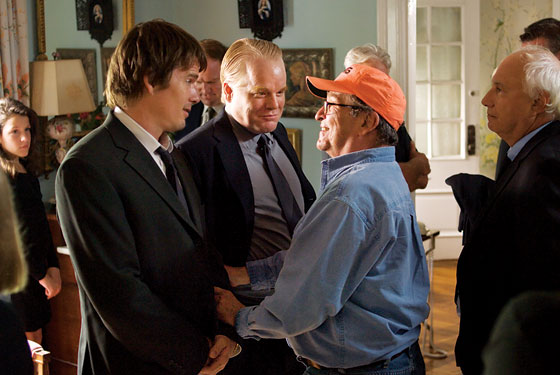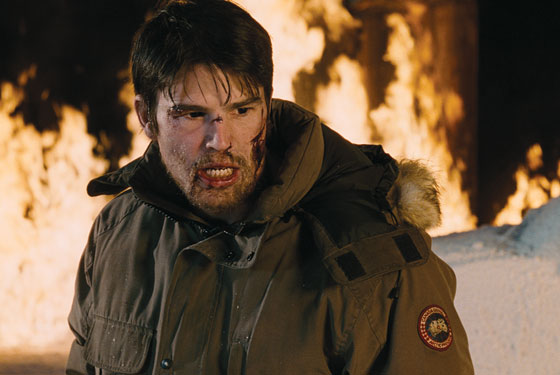
On the occasion of his bloody and tumultuous new film, Before the Devil Knows You’re Dead, critics have hailed the 83-year-old director Sidney Lumet as an American master, generously neglecting to mention that for every great picture (Serpico, Dog Day Afternoon), there have been maybe four breathtaking stinkers (The Wiz, Equus, Deathtrap, Family Business, Guilty As Sin, Gloria, A Stranger Among Us, Garbo Talks…). I note Lumet’s batting average to underscore his present achievement. His touch in Before the Devil is so sure, so perfectly weighted, that it’s hard to imagine him capable of making a bad movie. The thing is just enthralling. It’s a crime-and-punishment story that is finally about (to borrow an earlier Lumet title) family business: primal injuries that lead, inexorably, to primal sins.
Kelly Masterson wrote the screenplay, which hopscotches through time to penetrating effect. Before the Devil (the title comes from the cheeky adage “May you be in heaven for half an hour before the devil knows you’re dead”) opens with an explicit sex scene between Marisa Tomei and Philip Seymour Hoffman, who does not (as he’d be the first to admit) have a body for soft-core but whose naked passion shows us a side of the character we wouldn’t see otherwise. (For the record, Marisa Tomei does have a body for soft-core.) Hoffman plays Andy, an accounts manager at a realty company—but we don’t know that yet. Nor do we know the identity of the masked thug who bursts into a suburban jewelry store owned by Nanette (Rosemary Harris), while Hank (Ethan Hawke), in a ludicrous wig and mustache, waits in a car with the motor running. Catastrophe ensues, but before we go further, the movie skips back four days, then forward, then a few days back; and just as we think, “Enough of this pretzeled syntax, get on with it!” we’re pulled in again. This all sounds Tarantino-like, but Lumet doesn’t go in for shock-cuts and pixelated editing: His technique is spare, his gaze steady. The trickiness has a different end—not to flout our genre expectations but to untangle the strands that we know from early on will coalesce into a tragedy. To make sense of what follows, we need to go back.
Lumet and Masterson peel away the layers gradually, and to orient you too much would be criminal. But it’s fair to say the heart of the film is Hank and Andy, brothers unalike yet equally, desperately, in debt. Hank’s extravagantly contemptuous ex-wife (Amy Ryan) emasculates him in front of his young daughter with taunts about unpaid child support. Andy’s troubles are exponentially worse. Both could use a shoulder on which to cry—a parental figure, a nurturing spouse. But Andy only shares his woes with an icily disdainful transvestite smack dealer, while Hank looks for love with his brother’s wife. Their parents—well, that’s more complicated, the subtext bottomless. Andy thinks they owe him something, but he’s not about to express his neediness openly, and Hank is too weak to resist his brother’s enticements.
If Lumet is to be faulted, it’s for allowing (encouraging?) his actors to emote like crazy, with the camera close enough to count their nostril hairs. Hawke’s raw and twitchy Hank would be even more compelling from a couple of feet back and with his twitches reduced by a third. The problem with actors who think they’re way cool is that they think they have to work really, really hard to look uncool. Wrong. The close-up is also no friend to Albert Finney as Nanette’s husband, Charles—a magnificent snorting bull best viewed from the other side of the fence. The actors caught on the fly (Ryan, Aleksa Palladino, Arija Bareikis, Michael Shannon) are more entertaining. They’re fireflies—they spark the film along.
The exception to the too-close rule is Hoffman, who is huge but mesmerizing. He knows how to modulate his eruptions—he only lets go when it counts. He has an advantage in that Andy bears a surface similarity to the title character he played in Owning Mahowny, a compulsive gambler with the windows to his soul tightly shuttered. At first, Andy, like Mahowny, is borderline monotonic and controlled—dangerously controlled, it turns out, given what’s festering under the mask. In the face of disaster, Andy pulls even deeper into himself, but begins to reel like a man with an inner-ear infection. By the time he acts out, he has no defenses left. He’s stripped down to pure rage.
Before the Devil Knows You’re Dead has the random patch of David Mamet-y dialogue (it comes with the territory) and one pivotal absurdity—that Andy would entrust the scaredy-cat Hank to perform a task that would challenge the steeliest ego. But as Hoffman comes to a boil under Lumet’s sympathetic gaze, the movie transcends melodrama. The horror seems rooted in an ancient woe.

The deadpan comedy Lars and the Real Girl—the tale of an emotionally backward man (Ryan Gosling) and the sex doll he believes to be alive—is often howlingly funny, and the actors are a treat. But the underlying message is so suspect that it’s hard to suspend disbelief. I promise I tried. The film is a cross between that old chestnut Harvey, in which Elwood P. Dowd (James Stewart at his most dithering) pals around with an invisible six-foot rabbit but is otherwise sane and lovable, and The 40-Year-Old Virgin, which suggests that a man can go dateless for a quarter-century beyond puberty and still be basically healthy and sweet and harbor no resentment toward women. If only. Here, the idea is that, given his emotional baggage, Lars’s delusional relationship with Bianca, the life-size, anatomically correct doll, is profoundly adaptive. Odd, yes. Disturbing, yes. But on some Eriksonian level, healthy—a vital stage on the way to autonomy. If only. If only.
Gosling has grown a mustache and pudged up for the role, and when he lowers his chin and gives a fatuous little grin, his pink cheeks bulge adorably. I think he neuters himself, but I kept watching him; his timing is gorgeous, and he’s obviously invested in this cretin. When Lars sits on a sofa opposite his brother, Gus (Paul Schneider), and sister-in-law, Karin (Emily Mortimer), he’s beaming with joy. They wanted him to bring home a girl, and here she is! Mortimer is a miraculously tender comedian. Watch her face (which flushes easily) go from alarmed to empathetic to teary-sentimental to alarmed again—in one fluid movement. Watch Schneider go from alarmed to very alarmed to very, very, very alarmed without changing his expression. (He looks as if his head is about to explode.) The most remarkable performance comes from Patricia Clarkson as Dr. Dagmar, the general practitioner who helps to sustain Lars’s delusion—she plays it utterly low-key and straight, which in context is startling. Lars’s mother died in childbirth, and his sister-in-law, on whom he’s subtly dependent, is pregnant. The shrinks in Marnie and Equus would try to dredge up the repressed horror and expose the life-lie. But Dagmar convinces Lars’s family and co-workers to pretend that Bianca is real, too, and let the relationship take its natural course—which of course it does. If only. If only. If only.
Given its one-joke premise, Lars and the Real Girl goes on too long and repeats itself too often, but the writer, Nancy Oliver, and director, Craig Gillespie, are increasingly inventive in their use of Bianca—who “takes a job” and “reads” to children and gradually wins our affection. She has downcast eyes and a wide mouth made for blow jobs but with just the right hint of melancholy. I wish I could have pushed out of my mind all those horror movies in which delusional schizophrenics develop symbiotic relationships with inanimate objects and end up butchering the supporting cast. If you think you can, by all means see the movie. It’s a good thing for each of us, as movie lovers, to draw our own line between healthy and unhealthy fantasy.
Are vampires a healthy or unhealthy fantasy? I go back and forth but was eager to see 30 Days of Night, based on a graphic novel about bloodsuckers (or, more precisely, throat-rippers) that arrive in Barrow, the northernmost Alaskan town, after its last sunset for a month. Not to get all Hannibal Lecter, but there’s something about blood glowing black on white snow in the moonlight … The director is David Slade, who made the amusingly perverse two-character pedophile psychodrama Hard Candy, and who works here mostly in fast, tight close-ups broken by showers of gore. The vampires are big Slavic rats that howl and shriek and tear out jugulars with their long talons. I like my vampires less feral, but Danny Huston is screamingly funny as the alternately finicky and savage Head Ghoul—he’s like something spewed forth from the bowels of the Politburo. The problem is structural. After the invasion, we’re marooned with the dull survivors (led by Sheriff Josh Hartnett) in an attic for long stretches while the titles read “Day 17” … “Day 21” … The vampires, meanwhile, mill around doing … It’s never clear. They act like beach-house renters with lousy weather who won’t leave until 11 a.m. Saturday no matter how bored they get. Moviegoers who’ve paid $11 will probably stay in their seats for the same reason.
Before the Devil Knows You’re Dead
Directed by Sidney Lumet. Thinkfilm. R.
Lars and the Real Girl
Directed by Craig Gillespie. MGM. PG-13.
30 Days of Night
Directed by David Slade. Sony Pictures. R.
E-mail: filmcritic@newyorkmag.com.
